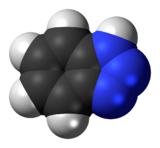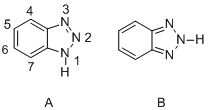Chemistry:Benzotriazole

| |

| |
| Names | |
|---|---|
| Preferred IUPAC name
1H-1,2,3-Benzotriazole | |
| Other names
1H-Benzotriazole; 1,2,3-Benzotriazole; BTA; BtaH
| |
| Identifiers | |
3D model (JSmol)
|
|
| ChEBI | |
| ChEMBL | |
| ChemSpider | |
| EC Number |
|
PubChem CID
|
|
| RTECS number |
|
| UNII | |
| |
| |
| Properties | |
| C6H5N3 | |
| Molar mass | 119.127 g·mol−1 |
| Appearance | White solid |
| Density | 1.36 g/mL[1] |
| Melting point | 100 °C (212 °F; 373 K)[2] |
| Boiling point | 350 °C (662 °F; 623 K)[2] |
| 20 g/L[2] | |
| Acidity (pKa) | 8.2[3][4] |
| Basicity (pKb) | > 14[4] |
| Hazards | |
| GHS pictograms |  
|
| GHS Signal word | Warning |
| H302, H319, H332, H411, H412 | |
| P261, P264, P270, P271, P273, P280, P301+312, P304+312, P304+340, P305+351+338, P312, P330, P337+313, P391, P501 | |
| Related compounds | |
Related compounds
|
Benzimidazole, Tolyltriazole |
Except where otherwise noted, data are given for materials in their standard state (at 25 °C [77 °F], 100 kPa). | |
| Infobox references | |
Benzotriazole (BTA) is a heterocyclic compound with the chemical formula C6H5N3. Its five-membered ring contains three consecutive nitrogen atoms. This bicyclic compound may be viewed as fused rings of the aromatic compounds benzene and triazole. This white-to-light tan solid has a variety of uses, for instance, as a corrosion inhibitor for copper.[5]
Structure
Benzotriazole features two fused rings. Its five-membered ring can in principle exist as tautomers A and B:[6]
Various structural analyses with UV, IR and 1H-NMR spectra indicate that tautomer A is dominant.
Synthesis and reactions
Synthesis of benzotriazole involves the reaction of o-phenylenediamine, sodium nitrite, and acetic acid. The conversion proceeds via diazotization of one of the amine groups:[7][8]
The synthesis can be improved when the reaction is carried out at low temperatures (5–10 °C) and briefly irradiated in an ultrasonic bath.[9] Typical batch purity is 98.5% or greater.[10]
Reactions
BTA is a weak acid with a pKa = 8.2)[3][4]
It is a very weak Brønsted base with pKa < 0).[4]
Not only can it act either as an acid or base, it can also bind to other species, utilizing the lone pair electrons. Applying this property, the BTA can form a stable coordination compound on a copper surface and behave as a corrosion inhibitor.[6]
Benzotriazole (BtH) reacts with aromatic aldehydes (ArCHO) in the presence of ethanol to give benzotriazole-based N,O-acetals:
- ArCHO + BtH + EtOH → ArCH(OEt)(Bt) + H
2O
These acetals are susceptible to deprotonation, giving access to acylsilanes[11] and acylboranes.
N-amination of BtH with hydroxylamine-O-sulfonic acid gives 1-aminobenzotriazole. Oxidation of this amine with lead(IV) acetate affords benzyne, which rapidly dimerises to biphenylene.[12]
Applications
Benzotriazole has been known for its great versatility. It has already been used as a restrainer (or anti-fogging agent) in photographic emulsions or developing solutions, and as a reagent for the analytical determination of silver. More importantly, it has been extensively used as a corrosion inhibitor in the atmosphere and underwater. Also, its derivatives and their effectiveness as drug precursors have been drawing attention. Besides all the applications mentioned above, the BTA can be used as antifreezes, heating and cooling systems, hydraulic fluids, and vapor-phase inhibitors as well.[6]
Corrosion inhibition
Benzotriazole is an effective corrosion inhibitor for copper and its alloys by preventing undesirable surface reactions. It is known that a passive layer, consisting of a complex between copper and benzotriazole, is formed when copper is immersed in a solution containing benzotriazole. The passive layer is insoluble in aqueous and many organic solutions. There is a positive correlation between the thickness of the passive layer and the efficiency of preventing corrosion.[13] BTA is used in heritage conservation, notably for the treatment of bronze disease. The exact structure of the copper-BTA complex is controversial and many proposals have been suggested.[citation needed]

Drug precursor
Benzotriazole derivatives have chemical and biological properties that are versatile in the pharmaceutical industry. Benzotriazole derivatives act as agonists for many proteins. For instance, vorozole and alizapride have useful inhibitory properties against different proteins. Benzotriazole esters are used as mechanism-based inactivators to treat severe acute respiratory syndrome (SARS) by inhibiting the SARS 3CL protease of the SARS-CoV-1 virus. The methodology is not only limited to heterocyclization but was also successful for polynuclear hydrocarbons of small carbocyclic systems.[14]
Environmental relevance
Benzotriazole is fairly water-soluble, not readily degradable and has a limited sorption tendency. Hence, it is only partly removed in wastewater treatment plants and a substantial fraction reaches surface water such as rivers and lakes.[15] It is considered to be of low toxicity and a low health hazard to humans although exhibiting some antiestrogenic properties.[16]
Related compounds
Tolyltriazole is a mixture of isomers or congeners that differ from benzotriazole by the addition of one methyl group attached somewhere on the benzene ring. Tolyltriazole has similar uses, but has better solubility in some organic solvents.[citation needed]
References
- ↑ "1H-Benzotriazole (CAS 95-14-7)". https://www.emdmillipore.com/US/en/product/1H-Benzotriazole%2CMDA_CHEM-822315.
- ↑ 2.0 2.1 2.2 1H-Benzotriazole , SRC PhysProp Database
- ↑ 3.0 3.1 Katritzky, A. R.; Rachwal S.; Hitchings G. J. (14 January 1991). "Benzotriazole: A novel synthetic auxiliary". Tetrahedron 47 (16–17): 2683–2732. doi:10.1016/S0040-4020(01)87080-0.
- ↑ 4.0 4.1 4.2 4.3 Katritzky, A. R.. "Adventures with Benzotriazole". Lecture presented at various locations in 2002. Florida Center for Heterocyclic Compounds. Archived from the original on 26 April 2012. https://web.archive.org/web/20120426001244/http://www.ark.chem.ufl.edu/Lectures/Benzotriazole_2002.pdf. Retrieved 23 November 2011.
- ↑ "1,2,3-BENZOTRIAZOLE | CAMEO Chemicals | NOAA". https://cameochemicals.noaa.gov/chemical/19869.
- ↑ 6.0 6.1 6.2 Sease, Catherine (May 1978). "Benzotriazole: A Review for Conservators". Studies in Conservation. 2 23 (2): 76–85. doi:10.2307/1505798.
- ↑ Robert A. Smiley "Phenylene- and Toluenediamines" in Ullmann's Encyclopedia of Industrial Chemistry, 2002, Wiley-VCH, Weinheim. doi:10.1002/14356007.a19_405
- ↑ Damschroder, R. E.; Peterson, W. D. (1940). "1,2,3-Benzotriazole". Organic Syntheses 20: 16. doi:10.15227/orgsyn.020.0016.
- ↑ Pereira, Claudio M. P.; Stefani, Helio A.; Guzen, Karla P.; Orfao, Aline T. G. (2007-07-31). "Improved Synthesis of Benzotriazoles and 1-Acylbenzotriazoles by Ultrasound Irradiation.". ChemInform 38 (31). doi:10.1002/chin.200731104. ISSN 0931-7597. https://onlinelibrary.wiley.com/doi/10.1002/chin.200731104.
- ↑ "Benzotriazole - Chemical Supplier Distributor Chemceed". http://chemceed.com/products/benzotriazole/.
- ↑ Katritzky, Alan R.; Wang, Zuoquan; Lang, Hengyuan (1996). "Novel and Convenient Synthesis of Aroyl-, Heteroaroyl-, Alkenoyl-, and Alkynoylsilanes". Organometallics 15 (2): 486–490. doi:10.1021/om950712b.
- ↑ Campbell, C.D.; Rees, C.W. (1969). "Reactive intermediates. Part I. Synthesis and oxidation of 1- and 2-aminobenzotriazole". J. Chem. Soc. C 1969 (5): 742–747. doi:10.1039/J39690000742.
- ↑ Finšgar, M.; Milošev I. (11 March 2010). "Inhibition of copper corrosion by 1,2,3-benzotriazole: A review". Corrosion Science 52 (9): 2737–2749. doi:10.1016/j.corsci.2010.05.002.
- ↑ Kale, Raju R.; Virendra Prasad; Prabhu P. Mohapatra; Vinod K. Tiwari (6 March 2010). "Recent developments in benzotriazole methodology for construction of pharmacologically important heterocyclic skeletons". Monatsh Chemistry 141 (11): 1159–1182. doi:10.1007/s00706-010-0378-1.
- ↑ Giger, W; Schaffner, C; Kohler, HP (2006). "Benzotriazole and tolyltriazole as aquatic contaminants. 1. Input and occurrence in rivers and lakes". Environmental Science & Technology 40 (23): 7186–92. doi:10.1021/es061565j. PMID 17180965.
- ↑ Farré, Marinel la; Pérez, Sandra; Kantiani, Lina; Barceló, Damià (2008). "Fate and toxicity of emerging pollutants, their metabolites and transformation products in the aquatic environment". TrAC Trends in Analytical Chemistry 27 (11): 991–1007. doi:10.1016/j.trac.2008.09.010. ISSN 0165-9936.
 |




